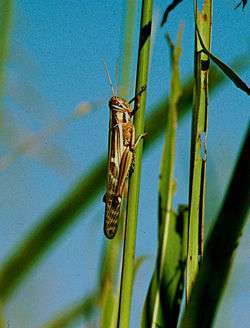Red locust
| Red locust | |
|---|---|
 | |
| Scientific classification | |
| Kingdom: | Animalia |
| Phylum: | Arthropoda |
| Class: | Insecta |
| Order: | Orthoptera |
| Suborder: | Caelifera |
| Family: | Acrididae |
| Subfamily: | Cyrtacanthacridinae |
| Genus: | Nomadacris |
| Species: | N. septemfasciata |
| Binomial name | |
| Nomadacris septemfasciata Audinet-Serville, 1883 | |
The red locust (Nomadacris septemfasciata) is a large grasshopper species found in Sub-Saharan Africa. Its name refers to the colour of its hindwings. It is sometimes called the Criquet nomade in French, due to its nomadic movements in the dry season. When it forms swarms, it is described as a locust.
Description
Adults
The overall colour of adult insects is a mixture of light beige and brown. They have seven brown transversal bands on the elytra, justifying the species name septemfasciata. The pronotum has two brown lateral bands.
Males are 60–70 mm (2.4–2.8 in) long; females are 60–85 mm (2.4–3.3 in) long.
Hoppers
Unlike adults, the colour of immature insects varies depending on their phase. When solitary they can be green or brown; when in large numbers (gregarious), they are bright yellow and red-brown with black markings.
 Hopper band in Iku-Katavi, Tanzania
Hopper band in Iku-Katavi, Tanzania Hoppers on wild sorghum stalk
Hoppers on wild sorghum stalk
Ecology
Red locusts actively seek out moist environments such as seasonal floodplains. Grains are their primary food source, so grassy lowlands are prime habitat. They also like spending time in trees and thus prefer some tree cover.
Red locusts are sedentary when ample shelter, perches and food is available. In dry years, when the amount of suitable habitat is reduced population densities increase. If the population density increases past a threshold, the locusts will transform into their gregarious phase, changing their behaviour and anatomy. When gregarious, red locusts keep together in large swarms and fly with the wind in daylight hours, looking for more food. The higher temperatures during daylight enable gregarious locusts to travel longer distances by flying longer and higher, aided by thermal lift.[1] A swarm will rarely move more than 20–30 km in a day. In contrast, solitary locusts prefer to fly in the dark and do so alone.[2]
Compared to their solitary phase, gregarious red locusts also have:
- reduced lifespan
- more markings
- 6 instar stages rather than 7
- longer sexual maturation
- larger and heavier young, although they lay fewer eggs
Swarming females often lay eggs at night. Their youngsters immediately behave gregariously and are capable of "hopping" hundreds of metres every day.
Outbreaks
Outbreak areas have been identified in Zambia, Tanzania, Malawi and also Madagascar and Réunion. In the Sahel, the species is observed on a more incidental basis in Cape Verde, the central Niger River delta in Mali and around Lake Chad. The last widespread plague occurred from 1930-1944, when almost all of southern Africa was invaded.

After unsuccessful efforts to control the locusts through environmental modifications, chemical agents are currently being used. A biological product based on an entomopathogenic fungus (Metarhizium acridum) is now available (see desert locust). It has been successfully tested on both nymphs and adults of the red locust.
References
- "Les criquets ravageurs". CIRAD - French Agricultural Research Centre for International Development. Retrieved 2008-11-06. External link in
|publisher=(help) - Nomadic cricket. (2008, July 24). French Wikipedia. Accessed 12:23, November 6, 2008 from http://fr.wikipedia.org/w/index.php?title=Criquet_nomade&oldid=31856681.
Notes
- ↑ Farrow, R.A. "Flight and Migration in Acridoids". Biology of Grasshoppers. John Wiley and Sons.
- ↑ Chapman, R.F. (1959). "Observations On the Flight Activity of the Red Locust, Nomadacris Septemfasciata (Serville)". Behaviour. 14 (1): 300–334. doi:10.1163/156853959X00126.